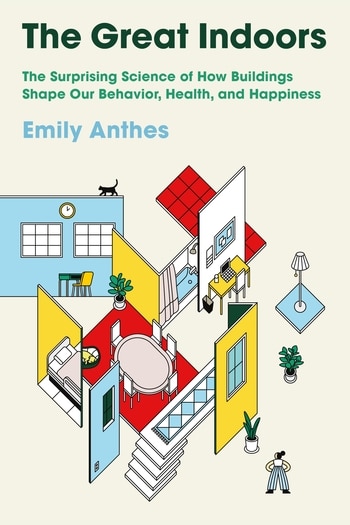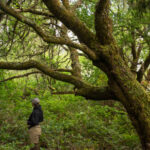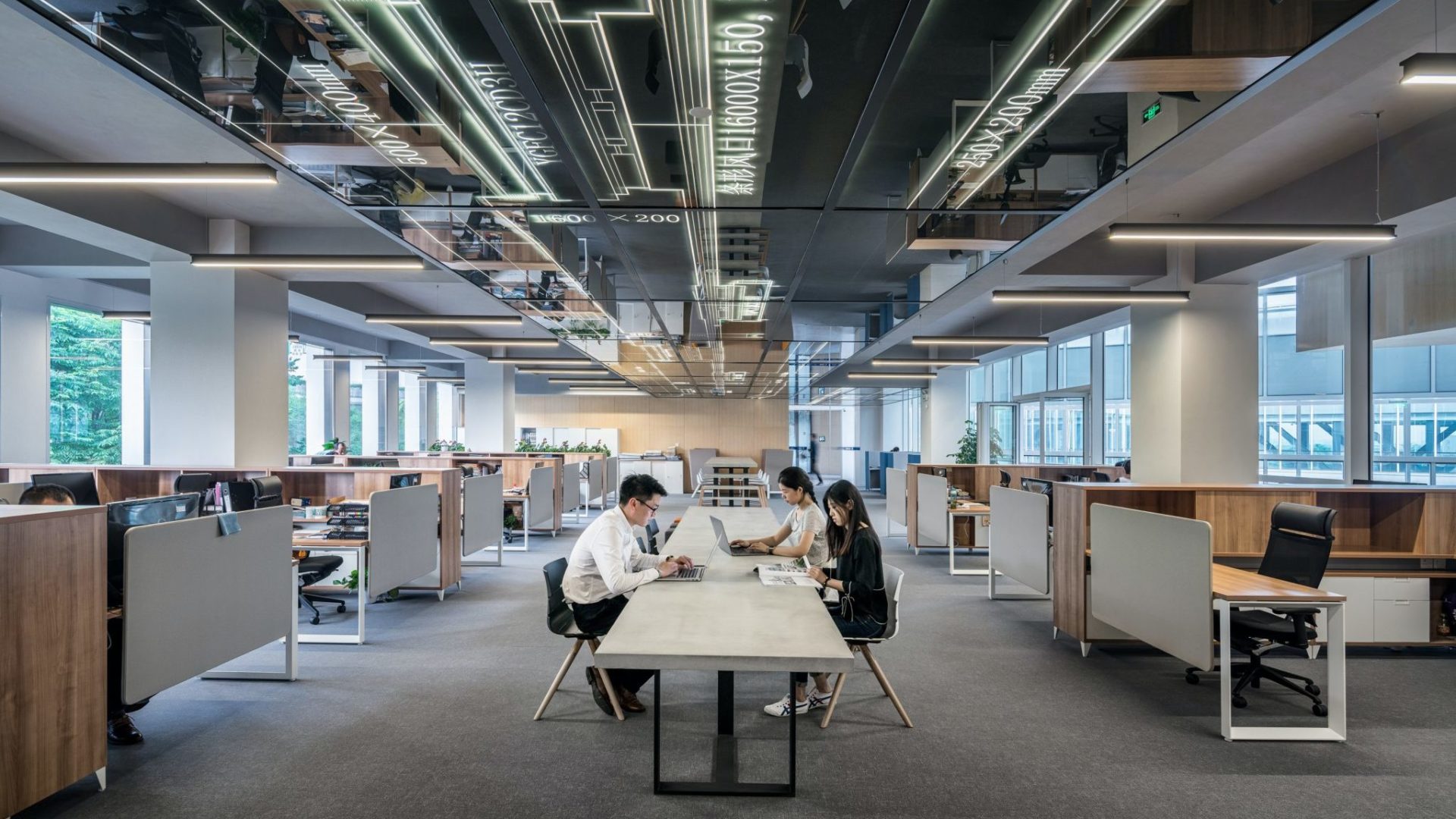Emily Anthes might seem particularly suited to sheltering in place during the Covid-19 pandemic. The author of “Frankenstein’s Cat,” an award-winning exploration of animals and biotechnology, Anthes calls herself, “unapologetically indoorsy,” so it’s fitting that her new book is about the rich and diverse world inside. With so many of us spending more time than ever at home, “The Great Indoors: The Surprising Science of How Buildings Shape Our Behavior, Health, and Happiness” couldn’t be more timely.

BOOK REVIEW — “The Great Indoors: The Surprising Science of How Buildings Shape Our Behavior, Health, and Happiness” by Emily Anthes (Macmillan Publishers, 304 pages).
The book begins with an exploration of the burgeoning field of indoor ecology. Anthes (who is an occasional contributor to Undark) explains that our homes are host to an “invisible menagerie of organisms” whose lives are intertwined with ours, whether we realize it or not. In one experiment, researchers asked residents of 40 different households to collect samples from the surfaces of everything from cutting boards to pillowcases, toilet seats, and TV screens. They found that on average, these homes were host to more than 2,000 kinds of microbial life, and there was more microbial diversity in the dust inside the homes than the samples collected outside of them.
Some of these microbes come from us. University of Chicago microbial ecologist Jack Gilbert and his colleagues have found that they can detect a sort of microbial fingerprint from individual household members. When the researchers sampled kitchens, they found that the space was dominated by the microbiomes of the people who spent the most time there. Meanwhile, among people who spent more time in the bedroom, “their microbiome dominated there. You could start to forensically identify their movement,” Gilbert told Anthes.
The more Anthes learned about the world of indoor microbes, “the more I found myself obsessing over my own invisible roommates,” she writes. “I began to feel like a stranger in my own home, humbled by how little I knew about what was happening under my roof.”
In search of answers, she swabbed her showerhead and sent the sample to a lab for analysis. She learned that this humble spigot is host to a “stunningly diverse array of organisms,” including mycobacteria, which can cause some “really nasty disease, including tuberculosis, leprosy, and what are known as non-tuberculous mycobaterical lung infections.” It sounds like scary news, but the microbiologist she consults assures Anthes that “many of those could be totally non-pathogenic.” She explains that, “Until we can separate the good from the bad, it’s hard to know what to make of my results.”
She finds more certainty in the science of how indoor environments can influence the spread of infectious disease, a topic on many minds these days. She devotes a whole chapter to hospitals, and finds that Florence Nightingale was on to something when, in the late 1800s, the nurse intuited that “a steady flow of fresh air could slow the spread of contagious diseases.” Today, that same principle is guiding health advisories during the Covid-19 pandemic.
Nightingale also advocated for windows to give patients access to natural light and pavilion-style hospital designs that had a central corridor with long, slender patient wards extending from them, separated from one another by natural spaces like gardens that increased cross-ventilation. This layout allowed patients “ready access to fresh air, daylight, and nature,” Anthes writes, but the trend didn’t last. “As germ theory and the concept of antisepsis gained ground, hospitals sealed themselves off from the natural world, relying on antibiotics and chemical disinfection, rather than sunlight and fresh air, to reduce the spread of disease.”
By the late 20th Century, hospitals had become “cold, sterile environments designed to optimize staff efficiency rather than patient healing,” Anthes writes.
But the tide began to turn in the 1980s, when health care design researcher Roger Ulrich examined the medical records of 46 patients who’d been hospitalized for gallbladder surgery. He found that patients who’d recovered in hospital rooms that overlooked a small cluster of trees needed less pain medication and were discharged a day earlier than patients whose rooms stared out at a brick wall. Ulrich’s study, published in the journal Science, signaled the birth of a field known as “evidence-based design,” which uses empirical data to improve patient outcomes through architectural design.
Planners in Ohio put these principles into practice by building a new hospital, Dublin Methodist, based in part on designs laid out by architect Derek Parker and his colleagues in a conjured up “Fable Hospital” that used design features shown to improve patient outcomes and staff satisfaction. During its first few years, Dublin Methodist Hospital posted “sky high” patient satisfaction ratings, and problems like patient falls, hospital-acquired infections, and medical mistakes were rare, Anthes writes. It’s powerful stuff, but Anthes urges a dose of caution in interpreting the results, as “hospitals are complex environments, and it’s difficult to quantify precisely how much the hospital’s design contributed to its success.”
In a chapter aptly titled, “The Cure for the Common Cubicle,” Anthes explores the research on another topic gaining increased attention in the Covid age: workplace design. Employers may like open office plans, but employees tend to hate them for the lack of privacy, frequent distractions and, especially, the noise, Anthes writes. The pandemic might prod employers to reconsider housing their workers in such close proximity. A Danish study published in 2011 found that employees who worked in open offices took 62 percent more sick days than those who worked in private offices, Anthes writes, and furthermore, private offices “seem to provide the same protection from infectious disease that private hospital rooms do.”
Anyone who’s ever worked in an office knows that the workplace environment can exert a large influence on productivity and mood, and Anthes writes about a clever set of experiments conducted to quantify this. Researchers at the Mayo Clinic and the New York-based real estate company Delos created an office space in which they could manipulate environmental conditions ranging from lighting to temperature, background music, floor plans, and office layouts. Then they put real workers in there, doing their actual office jobs, and observed and measured how changes to the workspace affected these employees. As any woman who has ever been forced to work in an air conditioned building in the summer can confirm, the study subjects were most unhappy and uncomfortable when the space was chilly, reporting that “the discomfort made it harder to get work done and that their inability to change the conditions around them left them feeling helpless.”
Which leads to another important point: “Employees aren’t interchangeable cogs — we’re individuals with diverse desires, sensitivities, and needs,” Anthes writes. “In general, women tend to be more sensitive to temperature than men and to prefer warmer workspaces,” so it’s probably not surprising that there’s research showing that “women score best on cognitive tests at warm temperatures, while men do better at cooler ones.”
Anthes has taken on a wide-ranging topic, which she has turned into an accessible and delightful read. Other topics she covers include ways the built environment can influence how physically active people are, and how architects are using this information to help schools and other buildings encourage physical activity without making mobility more difficult for people with disabilities. She also writes about how buildings are being adapted to better serve people with autism and how a design approach called DeafSpace is making it easier for people to communicate with one another at Gallaudet University, whose students are mostly people with deafness or other hearing problems. Anthes also explains ways that planners are making buildings more adapted to flooding, and the book concludes with a fascinating chapter on extraterrestrial living spaces and how we might design buildings on Mars.
“The Great Indoors” is perfectly paced and well-researched, packed with compelling stories and facts that inform and, at times, disgust. (One expert confirms my long-held belief that carpet is a disgusting sponge for germs and filth.) After considering the large body of research she’s gathered here, Anthes comes to a hopeful conclusion, “We have the tools and techniques to build a happier, healthier world,” she writes. We just have to decide to use them.












Comments are automatically closed one year after article publication. Archived comments are below.
Of course I haven’t read the book yet but I’m surprised Ms. Athnes didn’t mention the many IAQ benefits offered by the US Green Buuilding Council’s LEED program or the WELL program. From simple strategies like minimizing VOC content in finish materials or addressing issues such as daylighting, airflow and even things like circadian rhythym in healthcare facilities LEED is a strong and almost universally recognized standard for improving the indoor environment.